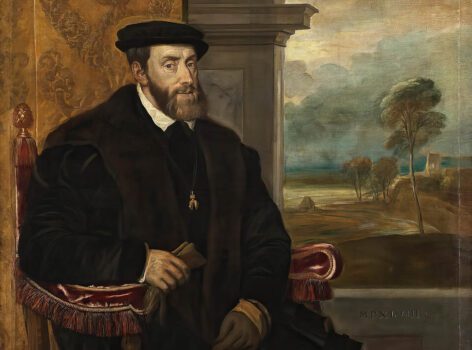Charles V, Holy Roman Emperor: Majesty and Intrigue of an Empire
In the event of European history, few figures cast a shadow as vast as Charles V, Holy Roman Emperor. Born in 1500 in Ghent, in what is today Belgium, Charles would become a ruler whose dominions stretched from the sun-scorched plains of Spain and the Americas to the misty lowlands of the Netherlands, across the fractured principalities of Germany, and even into Italy. Yet, despite his vast holdings, his reign was a balancing act, an intricate dance of diplomacy, war, and family alliances. The contradictions in his life are perhaps best captured in the grand portraiture of the Italian master Titian, whose brush immortalized Charles in a pose of supreme majesty, masking the turbulence and intrigue that plagued his empire.
Why Charles V Was the Holy Roman Emperor
To understand Charles V’s significance, one must first understand the Holy Roman Empire itself, a sprawling, semi-autonomous collection of principalities, duchies, free cities, and ecclesiastical territories that covered much of central Europe. Though the title “Emperor” implied unity, the reality was far more complex: power was dispersed, and the Emperor’s authority often depended on the consent of regional princes and the Pope.
Charles inherited his claim to this sprawling empire through his lineage. He was the son of Philip the Handsome of the Habsburgs and Joanna the Mad of Castile. Through his father, he inherited the extensive Habsburg territories in Austria and the Low Countries. Through his mother, he inherited Spain, including its burgeoning colonial empire in the Americas. In 1519, following the death of his grandfather, Maximilian I, Charles was elected Holy Roman Emperor by a coalition of prince-electors, solidifying his position as one of the most powerful monarchs in European history.
The title “Holy Roman Emperor” carried immense symbolic weight. It was both a continuation of the ancient Roman legacy and a spiritual mantle sanctioned by the Pope. Charles, as Emperor, was not merely a political figure, he was seen as the protector of Christendom, entrusted with defending the Catholic faith against both internal and external threats. This dual spiritual and temporal authority was a double-edged sword: it granted immense prestige but also bound him to a web of religious and political obligations that would dominate his reign.
A Portrait of Majesty: Titian and the Art of Imperial Power
In 1548, the Venetian master Titian painted Charles V astride a horse in what would become one of the most iconic portraits of a ruler in European history. The painting, Charles V at Mühlberg, depicts the Emperor as a commanding figure, clad in armor, his gaze steady and authoritative, the horse striding forward with a sense of unstoppable momentum. This was no mere likeness; it was a statement.
Titian understood the power of image. Charles V’s empire was vast but fraught with rebellion, external threats, and political rivalry. To convey strength and unity, the Emperor had to project an image of majesty that transcended the uncertainties of realpolitik. In the painting, the sword glints in sunlight, the armor gleams, and Charles sits perfectly upright, symbols of military prowess, divine favor, and personal discipline. It was a deliberate counterpoint to the instability of his reign: the painting suggested an emperor in control, a ruler whose authority was both unquestioned and absolute.
Yet, the majesty of Titian’s brushwork cannot hide the reality of Charles’s reign. Behind the gilded image lay a world of political maneuvering, religious conflict, and personal struggle, a kingdom where loyalty was often conditional and alliances were fragile.
The Weight of the Empire: Intrigue, Conflict, and Rebellion
Despite the grandeur of his image, Charles V’s reign was plagued by constant intrigue. The Holy Roman Empire was not a centralized state like France or Spain; it was a patchwork of semi-independent territories, each with its own local rulers and interests. Charles faced numerous rebellions from the German princes, who were increasingly drawn to Protestant ideas following Martin Luther’s challenge to the Catholic Church. The Protestant Reformation fractured Europe, and Charles, as the staunch defender of Catholicism, found himself drawn into a series of religious conflicts that would dominate his reign.
In addition to internal religious strife, Charles contended with external threats. The Ottoman Empire under Suleiman the Magnificent was expanding into Europe, posing a constant military challenge. Meanwhile, in France, Francis I represented a rival who sought to check Habsburg power at every turn. Charles’s dominions in Italy were continually contested by local city-states and foreign powers, and even his territories in the Americas demanded attention across oceans.
This constant balancing act required not only military might but also a deft hand in diplomacy. Marriage alliances, treaties, and negotiations were tools Charles used to maintain the fragile unity of his empire. Yet, even the most skilled emperor could not fully control the sprawling territories he ruled, and the constant pressures of governance weighed heavily upon him.
The Sack of Rome: Why Charles V Turned on the Papacy
One of the most dramatic moments of Charles’s reign came in 1527, when imperial troops sacked Rome. This event shocked Europe and marked a turning point in the relationship between the Emperor and the Papacy. But why did Charles allow, or even tacitly enable, such a catastrophe?
The answer lies in a combination of military necessity, political maneuvering, and the fractured loyalties of the time. Charles was engaged in ongoing conflicts with the League of Cognac, a coalition that included France, the Papal States, and various Italian city-states. The Emperor’s troops, largely unpaid and poorly supplied, mutinied and marched on Rome. What was intended as a show of force against political opponents spiraled into a brutal sack, with widespread destruction and looting.
While Charles had not personally ordered the atrocity, he bore the responsibility as the ultimate authority. The event exposed the fragility of his control and highlighted the tensions inherent in ruling a vast empire with multiple, often conflicting, centers of power. It also underscored the harsh realities of early modern European politics: even an emperor could not always restrain the ambitions and impulses of his own forces.
How Powerful Was Charles V?
In terms of sheer territorial scope, few monarchs in history have matched Charles V. He ruled Spain, the Netherlands, Austria, parts of Italy, and the Americas, and held the title of Holy Roman Emperor, giving him influence across central Europe. Yet, power is not simply about territory; it is also about control, influence, and the ability to project authority.
Charles’s power was both immense and constrained. He commanded vast armies, collected revenues from a wide range of territories, and influenced the religious and political direction of Europe. Yet, his authority was often dependent on cooperation from local rulers, and his empire was a constant site of rebellion and dissent. In many ways, his power was more symbolic than absolute, a reminder that even the most formidable rulers must navigate the complex interplay of loyalty, ambition, and circumstance.
Who Threatened Charles V the Most?
Among Charles’s many adversaries, Francis I of France was perhaps the most persistent and formidable. The French king sought to expand his own influence in Italy and check Habsburg dominance, leading to a series of conflicts known as the Italian Wars. Francis’s cunning diplomacy, willingness to form alliances with the Ottoman Empire, and skill in battlefield strategy made him a constant thorn in Charles’s side.
In addition to France, Charles faced the rising Ottoman Empire, which threatened Habsburg holdings in eastern Europe, and internal Protestant rebels, who challenged his religious authority. Even within his own family, conflicts over succession and territorial claims created tension and forced Charles to act with caution. It was a world where loyalty was fluid and the line between friend and foe was constantly shifting.
Despite the majesty of his public persona, Charles V’s later years were marked by personal struggle and introspection. In 1556, exhausted by decades of warfare, political strife, and religious conflict, he abdicated his thrones, dividing his empire between his son Philip II of Spain and his brother Ferdinand I, who became Holy Roman Emperor. Charles retired to the Monastery of Yuste in Spain, seeking solace in religion and contemplation.
In his final years, Charles reflected on the burdens of empire and the fleeting nature of power. The vast territories he had governed, the wars he had fought, and the image of majesty he had cultivated through artists like Titian all contrasted sharply with the simplicity of monastic life. His retreat was a reminder that even the most powerful ruler is ultimately subject to human limitations and mortality.
Legacy, Majesty and Contradiction
Charles V remains a figure of enduring fascination because of the contradictions that defined his life. He was a ruler of immense power, yet constantly constrained by the realities of governance. He projected majesty and authority, yet his reign was plagued by intrigue and rebellion. He defended the Catholic faith, yet faced the rise of Protestantism and the challenge of religious reform.
Titian’s portrait of Charles V captures one facet of this complex ruler: the image of an emperor in control, majestic and commanding. Yet history reminds us that behind the gilded image lay a human being navigating a world of extraordinary challenges. The majesty was real, but so too were the burdens, the enemies, and the relentless pressures of empire.
Charles V’s story is not simply one of conquest or power, it is a story of ambition, duty, and the human struggle to balance authority with the turbulent forces of history. His reign exemplifies the complexities of early modern Europe, where art, politics, religion, and war were inseparably intertwined, and where the image of power was sometimes the only thing that could hold the sprawling empire together.




